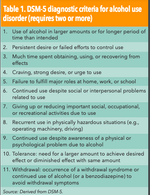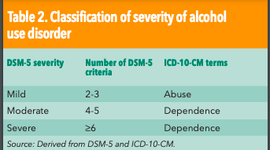CCO has a free resource here on alcohol & smoking:
I feel you do not need the R56.9 code since code F10.231 includes delirium which covers the seizures according to the DSM-5.
The preferred diagnostic term for problematic alcohol use is alcohol use disorder (AUD). Terms like “alcoholism” and “alcohol addiction” have fallen into disfavor because they may imply a moral judgment and stigmatize the patient's medical condition. According to DSM-5, the diagnosis of AUD requires a “problematic pattern of alcohol use leading to clinically significant impairment or distress.”
The diagnosis and severity of AUD depend on the presence of 11 diagnostic criteria described by the DSM-5 (Table 1).
View attachment 1044
Of importance, at least two criteria must be present for the diagnosis of AUD. Severity is then classified as mild, moderate, or severe based on the number of diagnostic criteria identified (Table 2). Alcohol screening questionnaires may be used to identify patients with a high risk of AUD but do not establish a diagnosis.
View attachment 1045
For the criterion regarding withdrawal (11th in Table 1, the occurrence of an actual withdrawal syndrome is not an absolute requirement. Simply the fact that alcohol is continually consumed to avoid withdrawal symptoms is enough. This determination may be based on a history of symptoms occurring when alcohol use was temporarily interrupted or on clinical judgment that withdrawal symptoms are likely to occur if use is discontinued.
Withdrawal is defined by DSM-5 as the occurrence of two or more of the following symptoms over several hours to a few days following sudden cessation or reduction of alcohol use:
- autonomic hyperactivity (e.g., sweating, tachycardia),
- hand tremor,
- insomnia,
- nausea or vomiting,
- transient hallucinations,
- psychomotor agitation,
- anxiety,
- or generalized seizures.
ICD-10-CM assumes alcohol dependence is necessary for withdrawal (no codes for use or abuse) and provides separate codes based on whether withdrawal is uncomplicated or associated with delirium or with perceptual disturbance (hallucinations without delirium or with intact reality testing). Withdrawal is not a toxic encephalopathy or a toxic effect (poisoning) of alcohol since it is caused by withdrawal of the toxin. Delirium tremens is coded as alcohol withdrawal with delirium. (
Delirium tremens is a severe form of alcohol withdrawal. It involves sudden and severe mental or nervous system changes).
Identification of AUD in remission is essential for documentation and coding purposes. The DSM-5 defines remission as the absence of any AUD diagnostic criteria (other than craving/desire/urge for alcohol) for at least three months. ICD-10-CM has multiple remission combination codes for various circumstances. For example, code F10.11 is for mild alcohol use disorder in remission.
Learn the ICD-10-CM terminology and instructions and DSM-5 definitions needed to document alcohol use disorder.

acphospitalist.org





